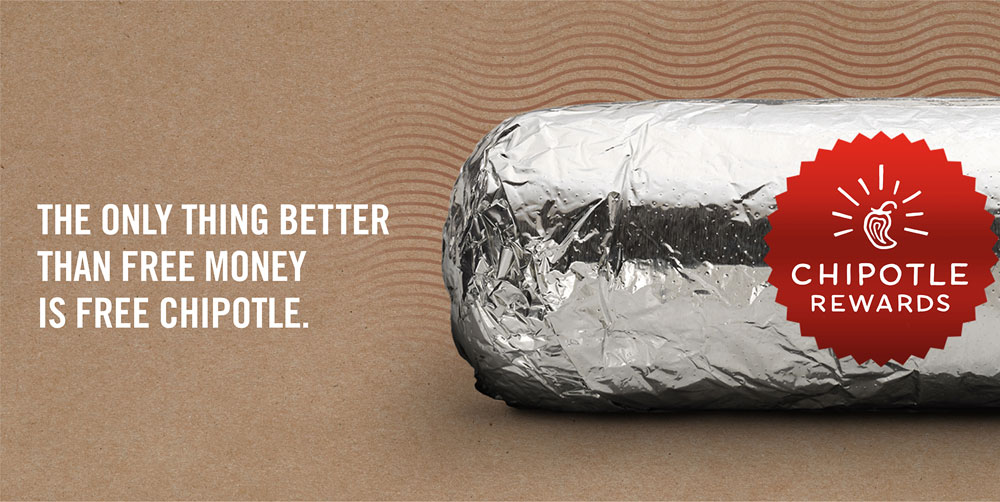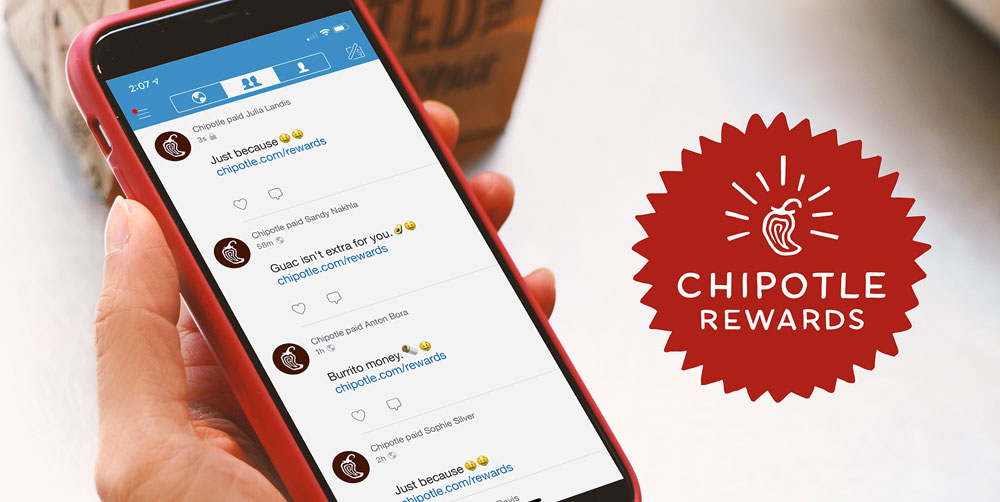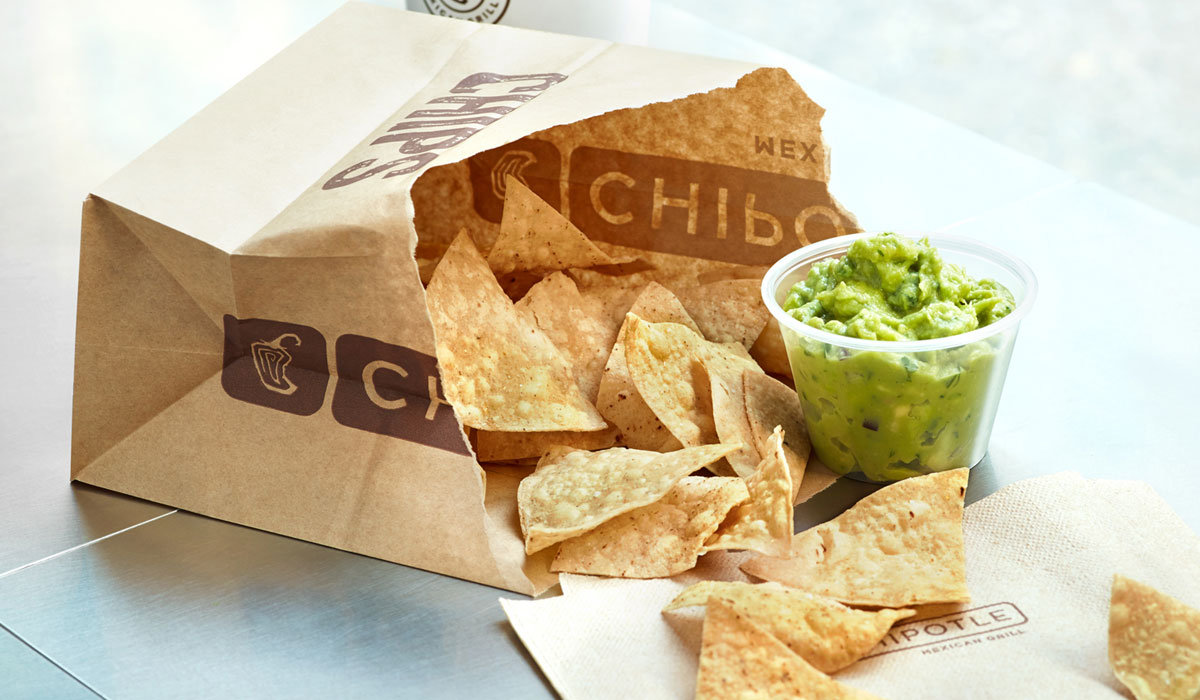If there’s one thing you could say about Chipotle’s run under executive Brian Niccol, it’s that the fast casual is far more agile in regards to restaurant trends. You could even argue it was stubborn under previous management. Queso. The drive thru. Menu changes. Chipotle’s outcast operating nature was both why it stood out in quick service, and then, in some ways, why it struggled to reenergize consumers once the food-safety crisis weakened brand perception.
Along those same lines is loyalty. In July 2016, Chipotle famously spent millions on Chiptopia—a program that was, in typical brand fashion, nothing like the standard points-based rewards platform you see from other chains. The virtual version of the classic punch card. Chipotle’s program instead was a three-tiered, summer-focused, three-month promotion tied to the number of times customers visited Chipotle. By the end of the first 30 days, it had more than 3.6 million participants and accounted for 30 percent of transactions. As September rolled around, Chipotle said more than 3.1 million people were registered and had used Chiptopia cards. About 1.2 million users signed up in August alone. And here’s where the program got dicey.
READ MORE: Chipotle in 2019: Call it a comeback now.
It was structured where guests earned free meals after their fourth, eighth, and 11th visits each month. So if they bought 12 burritos over three months (four a month), they were eligible for four free burritos. That 33 percent return rate was far from a long-term strategy for Chipotle’s bottom line. Additionally, the company ended up forking out roughly $20 million to more than 85,000 Chiptopia members who qualified for the top draw—a catering package for 10 worth about $240.
The question for Chipotle was, did the program actually inspire loyalty? Or did it just give away a bunch of burritos? Industry trends tracker YouGov ran the data at the time and showed that consumer sentiment was still suffering from a food-safety hangover on Chiptopia’s July 1 launch date, with brand quality clocking a paltry 9.4 on a scale of –100 to 100. On September 30, that rating fell to 6.8 after almost three months of staying around the same mark.
In an email to Business Insider at the time, a Chipotle spokesperson said, “Chiptopia was not a perception tool, though other programs have been having a positive impact on consumer perceptions.”
The big issues: Chiptopia seemed too confusing for the average customer and wasn’t sustainable long-term for Chipotle from a numbers perspective. It helped inspire already loyal customers. It didn’t really create new ones. Morgan Stanley wrote a research note that said it helped convince core guests to resume their prior frequency. It did not, though, impact the more casual customers, those who made up 75 percent of Chipotle’s base. While Chipotle’s most loyal diners accounted for 60–70 percent of its visits at the time, the brand needed to recapture the average consumer if it wanted to cross the perception gap created by the E. coli crisis.
As BTIG analyst Peter Saleh wrote then, this was troubling since Chiptopia was not the gift that kept on giving. “The program’s end in September could alienate some customers just as they are getting accustomed to the rewards,” he said.
Welcome to the present
From a stage-gate process, Chipotle’s long-awaited loyalty program has been in the works for a while. The announcement it was piloting the fresh platform came in September, with 2019 as the target for a national launch. In early tests, Niccol said, Chipotle saw light, lapsed, medium, and heavy users enroll, and that the brand was “most interested in that data we get on this,” and Chipotle’s ability “to then turn around and remarket Chipotle to influence people’s behaviors going forward.”


That national launch arrived at last Tuesday morning, the company announced. And it came with the news Chipotle would use payment platform Venmo to give away up to a total of $250,000 to about 25,000 guests, through March 14.
“Similar to how we build restaurants where people live and work, we want to have a presence in all of the places our customers spend time digitally,” Curt Garner, chief digital and information officer at Chipotle, said in a statement. “Chipotle Rewards is another access point for consumers; a way for guests to engage with our promise of real ingredients prepared fresh daily and a way for us to say thank you for joining our mission of cultivating a better world.”
How it works:
Chipotle went far more traditional this time around. To start earning free Chipotle with Chipotle Rewards, guests sign up in the app or online. Those who enroll earn 10 points for every $1 spent in the restaurant, online, or in the app, with 1,250 points resulting in a free entrée. It will also allow Chipotle to one-to-one market in ways it hasn’t before, with bonuses, like extra point days, which can help members earn points faster. Put simply, Chipotle can now incentivize guests to sign up and, in turn, provide data around their spending habits. It can also offer promotions to keep them around, and it can push deals to bring them back. These are all—from a digital perspective at this engagement level—things Chipotle just wasn’t able to try before. There’s a hyper-personalized CRM program running behind the scenes Chipotle said allows for targeted communication to drive trial, menu exploration, and brand affinity.
Guests who sign up get free chips and guac after their first purchase. There are surprise birthday rewards, too.
Kate Hogenson, senior loyalty consultant at Kobie, said in an email to QSR that the new program is more catered to the customer than Chiptopia was.
“From a pure cashback point of view, Chiptopia had up to 30 percent payout while Chipotle Rewards starts at 6 percent before bonuses and promotions, which would still not approach the payout of Chiptopia, except for the lucky Venmo bonus winners,” Hogenson says. “However, the restrictions were many and varied on Chiptopia—your points zeroed out every month and your reward was valid for only 30 days. You didn’t earn anything extra for buying beverages or sides or double protein. You were limited to one entrée per day. Chipotle Rewards is a lot friendlier for more customers because they allow three purchases a day, six months to earn, and 60 days to use your rewards.”
“In summary, Chiptopia rewarded the frequent lunchtime burrito buyer who was already loyal and penalized ‘mom’ buying dinner for her family when she has many other meal choices,” she added. “It should be noted that Chiptopia was implemented at the height of PR backlash for Chipotle—reinforcing the habit for the lunchtime burrito buyer was an important strategy, too.”
On the Venmo note, Chipotle customers submit the phone number associated with their account at ChipotleRewardMe.com for a chance to receive anywhere between $1–$500. Within 24 hours, the chain said, recipients of the payouts will be alerted of the payment in the Venmo app with a payment note from Chipotle along with a customer Chipotle pepper emoji—a first of its kind in the restaurant industry on this platform.
“Chipotle is one of the first brands to utilize Venmo’s technology to engage with customers through this pay-out feature on the Venmo app,” Chris Brandt, chief marketing officer, said in a statement. “Our customers have been asking for a loyalty program for a long time and we’re excited to partner with Venmo to reach their highly engaged network of digital-first customers to launch Chipotle Rewards, where the more you Chipotle, the more you can get free Chipotle.”
“Chipotle is a beloved brand with a loyal customer following who already split and share their Chipotle orders in the Venmo feed,” added Greg Fisher, vice president of global brand and integrated marketing, PayPal. “It made perfect sense to connect our brands to reward customers with free money to celebrate the launch of Chipotle Rewards and we look forward to partnering with Chipotle on future projects.”
Earlier in the year, Saleh wrote that Chipotle could see 200 basis points of transaction growth following the national launch of its rewards program, which first tested in Phoenix, Kansas City, and Columbus Ohio. That would be similar in progress to when Panera Bread launched its version. The bakery brand gathered some 4.5 million users and generated 200 basis points of traffic growth from loyalty within a year of launching its MyPanera program in 2010.
Some other comps: Dunkin’s DD perks, introduced in 2014, has 9 million members and represents 12 percent of transactions. Panera’s, up to 28 million members, accounts for 52 percent. Starbucks, at 15 million members, is around 40 percent and members spend 20–70 percent more after joining.
The agility is real
Chipotle had a very strong fourth quarter. The brand’s same-store sales growth of 6.1 percent was its highest in six periods. Revenue of $1.23 billion sailed Wall Street expectations of $1.194 billion and adjusted earnings per share of $1.72 beat $1.37.
Here’s how 2018 trended:
- Q4 2017: 0.9 percent
- Q1 2018: 2.2 percent
- Q2 2018: 3.3 percent
- Q3 2018: 4.4 percent
- Q4 2018: 6.1 percent
Chipotle’s Q4 results comprised of 3.3 percent menu price increase, average check growth of 4.1 percent (3.3 percent pricing and 0.8 percent menu mix), and a 2 percent boost in comparable store transactions.
In the same vein as the loyalty, Chipotle’s future is defined by some changes it historically refused. Queso, of course, was one early move. Chipotle wrestled with early feedback but has since reworked the recipe. Another are “Chipotlanes.” As of February, there were 10 of the mobile-order pick up lanes live nationwide, returning a higher mix of digital sales and total restaurant sales, Niccol said. Chipotle plans to build “a few dozen more” in 2019 with a mix of freestanding and end-cap builds. CFO John Hartung said the company’s new restaurant investment this year will increase to an average of about $860,000 per new opening, mostly due to the further testing of the Chipotlanes.
Digitally speaking, Chipotle is making up for lost time. Chipotle’s digital sales boomed 66 percent in Q4, year-over-year, an acceleration from the 48 percent it saw in Q3. Digital sales totaled $158.6 million in the quarter and represented 12.9 percent of sales.
For the full year, digital sales exceeded $500 million and represented 10.9 percent of sales. Another stellar result: App downloads increased 72 percent, year-over-year, in 2018. Delivery sales increased roughly 13-fold compared to the fourth quarter of 2017.










